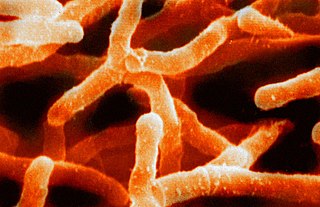Related Research Articles

The phylum "Bacteroidetes" is composed of three large classes of Gram-negative, nonsporeforming, anaerobic or aerobic, and rod-shaped bacteria that are widely distributed in the environment, including in soil, sediments, and sea water, as well as in the guts and on the skin of animals.
Fibrobacteres is a small bacterial phylum which includes many of the major rumen bacteria, allowing for the degradation of plant-based cellulose in ruminant animals. Members of this phylum were categorized in other phyla. The genus Fibrobacter was removed from the genus Bacteroides in 1988.

Gracilicutes is a clade in bacterial phylogeny.

Terrabacteria is a taxon containing approximately two-thirds of prokaryote species, including those in the gram positive phyla as well as the phyla Cyanobacteria, Chloroflexi, and Deinococcus-Thermus.

The FCB group is a superphylum of bacteria named after the main member phyla Fibrobacteres, Chlorobi, and Bacteroidetes. The members are considered to form a clade due to a number of conserved signature indels.

Bacterial phyla constitute the major lineages of the domain Bacteria. While the exact definition of a bacterial phylum is debated, a popular definition is that a bacterial phylum is a monophyletic lineage of bacteria whose 16S rRNA genes share a pairwise sequence identity of ~75% or less with those of the members of other bacterial phyla.
Saccharibacteria, formerly known as TM7, is a major bacterial lineage. It was discovered through 16S rRNA sequencing.

DPANN is a superphylum of Archaea first proposed in 2013. Many members show novel signs of horizontal gene transfer from other domains of life. They are known as nanoarchaea or ultra-small archaea due to their smaller size (nanometric) compared to other archaea.
The Orthokaryotes are a proposed Eukaryote clade consisting of the Jakobea and the Neokaryotes. Together with its sister Discicristata it forms a basal Eukaryote clade. They are characterized by stacked Golgi, orthogonal centrioles, and two opposite posterior ciliary roots.

The neokaryotes are a proposed eukaryote clade consisting of the unikonts and the bikonts as sister of for instance the Jakobea. It arises because the Euglenozoa, Percolozoa, Tsukubea, and Jakobea are seen in this view as more basal eukaryotes. These four groups, are traditionally grouped together in the Discoba. However, the Discoba may well be paraphyletic as the neokaryotes may have emerged in them.
The Scotokaryotes (Cavalier-Smith) is a proposed basal Neokaryote clade as sister of the Diaphoretickes. Basal Scotokaryote groupings are the Metamonads, the Malawimonas and the Podiata. In this phylogeny the Discoba are sometimes seen as paraphyletic and basal Eukaryotes.

Candidate phyla radiation is a large evolutionary radiation of bacterial lineages whose members are mostly uncultivated and only known from metagenomics and single cell sequencing. They have been described as nanobacteria or ultra-small bacteria due to their reduced size (nanometric) compared to other bacteria. Originally, it has been suggested that CPR represents over 15% of all bacterial diversity and may consist of more than 70 different phyla. However, a recently proposed standardized bacterial taxonomy based on relative evolutionary divergence found that CPR represents a single phylum. CPR lineages are generally characterized as having small genomes and lacking several biosynthetic pathways and ribosomal proteins. This has led to the speculation that they are likely obligate symbionts.
The Microgenomates are a proposed supergroup of bacterial candidate phyla in the Candidate Phyla Radiation.
Gracilibacteria is a bacterial candidate phylum formerly known as GN02, BD1-5, or SN-2. It is part of the Candidate Phyla Radiation and the Patescibacteria group.
Zixibacteria is a bacterial phylum with candidate status, meaning it had no cultured representatives. It is a member of the FCB group
Katanobacteria is a bacterial phylum formerly known as WWE3. It has candidate status, meaning there are no cultured representatives, and is a member of the Candidate Phyla Radiation (CPR).
Fertabacteria is a candidate bacterial phylum of the Candidate Phyla Radiation, first proposed in 2017 after analysis of a genome from the mouth of a bottlenose dolphin. Members of this phylum are predicted to have been widely under-detected in 16S rRNA gene-based surveys of community composition due to mismatches between commonly used primers and the corresponding primer site. Fertabacteria have been retroactively detected in a variety of environments.
CandidatusWirthbacteria is a proposed bacterial phylum containing only one known sample from the Crystal Geyser aquifer, Ca. Wirthibacter wanneri. This bacterium stands out in a basal position in some trees of life as it is closely related to Candidate phyla radiation but is not considered part of that clade.
Nomurabacteria is a candidate phylum of bacteria belonging to the CPR group so they are ultra-small bacteria. They have been found in a wide variety of environments, mainly in sediments under anaerobic conditions.
References
- ↑ Wrighton, Kelly C.; Thomas, Brian C.; Sharon, Itai; Miller, Christopher S.; Castelle, Cindy J.; VerBerkmoes, Nathan C.; Wilkins, Michael J.; Hettich, Robert L.; Lipton, Mary S.; Williams, Kenneth H.; Long, Philip E. (2012-09-28). "Fermentation, Hydrogen, and Sulfur Metabolism in Multiple Uncultivated Bacterial Phyla". Science. 337 (6102): 1661–1665. Bibcode:2012Sci...337.1661W. doi:10.1126/science.1224041. ISSN 0036-8075. PMID 23019650. S2CID 10362580.
- 1 2 Wrighton, Kelly C.; Castelle, Cindy J.; Wilkins, Michael J.; Hug, Laura A.; Sharon, Itai; Thomas, Brian C.; Handley, Kim M.; Mullin, Sean W.; Nicora, Carrie D.; Singh, Andrea; Lipton, Mary S. (July 2014). "Metabolic interdependencies between phylogenetically novel fermenters and respiratory organisms in an unconfined aquifer". The ISME Journal. 8 (7): 1452–1463. doi:10.1038/ismej.2013.249. ISSN 1751-7370. PMC 4069391 . PMID 24621521.
- ↑ Vigneron, Adrien; Cruaud, Perrine; Langlois, Valérie; Lovejoy, Connie; Culley, Alexander I.; Vincent, Warwick F. (2020). "Ultra-small and abundant: Candidate phyla radiation bacteria are potential catalysts of carbon transformation in a thermokarst lake ecosystem". Limnology and Oceanography Letters. 5 (2): 212–220. doi: 10.1002/lol2.10132 . ISSN 2378-2242.
- ↑ Orsi, William D.; Richards, Thomas A.; Francis, Warren R. (January 2018). "Predicted microbial secretomes and their target substrates in marine sediment". Nature Microbiology. 3 (1): 32–37. doi:10.1038/s41564-017-0047-9. ISSN 2058-5276. PMID 29062087. S2CID 3355333.